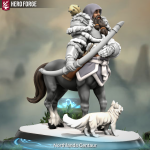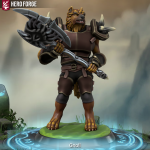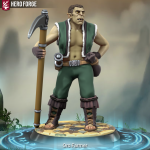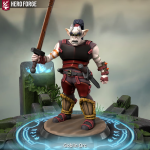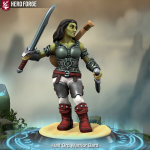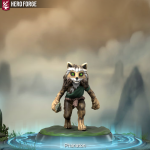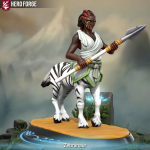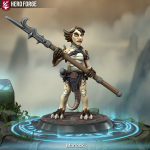PART FOUR: THE OTHER RACES
While the following races are less inclined to control specific regions of the continent, they are by no means minor races; however, they are the rarest races on the continent. Several have ties to specific lands or kingdoms such as Fatestone minotaurs, the Hutaakans and the griff. Others control specific city-states brought to Harqual during the time of The Transformation (i.e. the Jiltan).
CACTUS FOLK (Bas-Lag)
This race lives in the wastes of the Great Expanse and often come into conflict with the desert elves and bhuka. They are a race of plant creatures and favor the fighter class. They even have their own specialized racial weapons.
This is a brand new race, from the pages of Dragon Magazine #352. The article that details the race is based on the fictional world created by China Miéville, known as Bas-Lag.
FATESTONE MINOTAURS
The Fatestone minotaurs are the least known of the unique races from the City-state of Christopherson. This race of minotaurs rarely leaves the confines of that city-state; however, sometimes the Jiltan will ask a Fatestone minotaur to go on missions throughout the Far South to gather information and material wealth in order to help the city-state survive on this New World.
Fatestone minotaurs look like cursed minotaurs except that they are completely hairless and their skin seems to be made of Fatestone. Somehow, these strange, monstrous humanoids exist as living, breathing beings. Their skin is as hard and smooth as a steel blade, yet a Fatestone minotaur's skin feels soft to the touch. Their eyes are a deep violet in color and there teeth are a brilliant white.
What role Fatestone minotaurs once played in the former slave society of Christopherson remains a mystery. They and the other races of the strange city-state don't talk about it. Now, however, Fatestone minotaurs often act as soldiers for the city-state and guardians of specific locales in Christopherson that the Jiltan wish to remain isolated from its citizens and visitors. Each Fatestone minotaur seems to be a family of one. They seem to have only one gender and it isn't known how they reproduce or even if they can.
Fatestone minotaurs are naturally resistant to all forms of magic and they can shrug off physical damage as easily as a duck shrugs off water from its body. (Their natural damage reduction improves as they age; however, their natural resistance to magic is static: SR 25.) Fatestone minotaurs cannot learn to cast any sort of arcane magic; however, they could receive access to divine magic as clerics, druids, or any other divine spellcasting class.
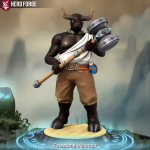 THE GRIFF
THE GRIFF
The griff are descended from griffons that have been magically altered by the tabaxi, who use them as a slave race. Most griff stand roughly 7-¾ ft tall and look like a strange mix of griffon and humanoid. Their hands are more like claws and their legs bend back at the knees and they have wings that allow them to glide. Griffs cannot truly fly and must start from an elevated position to become airborne. Good griff clerics worship the tabaxi god known as Sa the Tolerant, while evil griff clerics worship Erythnul. Note: Griff clerics are either killed by the tabaxi or exist in hiding throughout the other lands of Storm Peninsula.
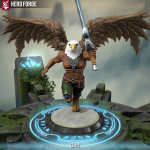 THE HUTAAKANS
THE HUTAAKANS
Hutaakans are a proud, hardened race of jackal-headed monstrous humanoids that live exclusively in the Rilous Mountains enclosing the land known as the Kingdom of Ahamudia. However, they do not control that entire mountain range. The Hutaakans live mainly in the western half of the range in and near the City of the Jackal, called Hutaalar.
The Hutaakans, like the citizens of Ahamudia, were brought to Harqual during the Transformation from the world known as Maran. On that world, the Hutaakans were a dying race, hunted by the Shard Soldiers of the Black Emperor of Kiltann. For years, they warred alongside the other races fighting against the Kiltanni Empire.
Unlike the other races, the Hutaakans were not viewed as good slave labor and those that were capture were either beheaded or sent to die in the Coliseum of the Colossus in the Imperial City of Skulai. Their numbers began to dwindle and the sheer number of shard soldiers sent to exterminate their kind soon overwhelmed the Hutaakans.
Those that survived fled west towards the Great Interior Sea or north towards what would become the Kingdom of Javeldos. Here in the southern tip of the Great Rileanaeousi Range, did a group of Hutaakans make their home. They built Hutaalar out of nothing but rock and time, until the day came when The Transformation brought them to Harqual and the World of Kulan. (All of the Hutaakans living in that range were transported to Kulan.)
Initially cutoff from their god, Vaflar, the jackal-headed humanoids kept to themselves and did not get involved with the war between Ahamudia and the Sword Empire. They did this because they feared that getting involved in another war would decimate their young folk and the elders were not will to take that risk.
Now, as their connection to the Lord of the Hutaakans has been re-established, they have felt comfortable enough to introduce themselves to the Javeldians now living on Harqual. (They had previously remained hidden when living on Maran.) They have signed several treaties with Ahamudia, Bitran, and the citizens of the Mines of Morhan. They have remained aloof towards the other lands surrounding the Rilous Mountains.
Hutaakan Traits
Hutaakans benefit from a number of racial traits:
- -2 to Strength, +2 to Intelligence, +2 to Wisdom.
- Hutaakans aren’t native to the World of Kulan and have the Extraplanar Subtype.
- Monstrous Humanoid: Hutaakans are monstrous humanoids, and are therefore immune to spells that only affect humanoids, such as charm person.
- Medium-size. As Medium-size creatures, hutaakans have no special bonuses or penalties due to their size. (Use human height and elf weight. See the PHB in Chapter 6: Description.)
- Speed: Base land speed is 30 feet.
- Darkvision out to 60 feet.
- +1 natural armor bonus.
- Hutaakans have a +4 racial bonus on Hide and Move Silently checks.
- Automatic Languages: Hutaakan and Orc (Maran). Bonus Languages: Draconic, Gnoll, Javeldian, and Vananean.
- Favored Class: Cleric. A multiclass hutaakan's cleric class does not count when determining whether he suffers an XP penalty for multiclassing.
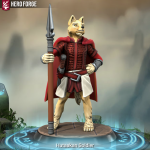 THE JERREN (Book of Vile Darkness)
THE JERREN (Book of Vile Darkness)
The lands of the Ragik Peninsula have existed under a veil of darkness for over a thousand years. The Old Sword Lands are infamous for the evil that infests its decadent cities and haunted ruins. However, when scholars debate about the evils of the Old Sword Lands, they rarely refer to the Jerren. This is usually due to the ignorance of the scholars regarding the existence of the Jerren. Demihumans are rarely encountered in the Old Sword Lands unless they are slaves, so the idea of a race of halflings that have embraced evil that live throughout the Ragik Peninsula is considered laughable.
You will not laugh if you meet these evil demihumans, however.
The Jerren live primarily throughout the Lehti Plains and near the fringes of the Imperiumi Forest; although, they can be encountered as far east as the Firetop Hills and as far south as the Räven Plains. They do not consider themselves citizens of the Old Sword Lands and, in fact, they often prey upon the human lands of the Ragik Peninsula. It isn't known how this race of evil halflings came into being but those that do know about them (and lived to tell about it) believe that the Jerren sold their souls to some ancient evil hundreds of years ago. It is believed they were once like other halflings but no one know fore sure.
The Jerren look like lightfoot halflings (that haven't slept for two weeks), but they can pass for hairfoots with a well-thought-out disguise. They enjoy infiltrating the human lands around them in order to cause as much chaos and suffering as possible. While the Jerren are highly nomadic, they rarely travel beyond the Ragik Peninsula. Instead, they wander the plains of the peninsula in the spring and summer, hunting and raiding, and live in hidden burrows during the fall and winter. They prefer to live on a diet of meat and enjoy eating intelligent prey.
The Jerren rarely worship the Sword Gods of the Sword Imperium and never worship the North Gods. Instead, they prefer to worship Interloper Gods such as Erythnul, Konkresh, Olidammara, or Uller. A few Jerren have been know to worship Gruumsh or Vaprak; however, these vile individuals are often loners as those two Interloper Gods are considered to be unappealing choices to the bulk of the Jerren community. While Jerren cannot be good-aligned, a few have chosen neutrality instead of evil as a way of life. These Jerren outcasts have been known to worship such Interloper Gods as Boccob, Dionysus, Hel, and even the halfling deity known as Mahridaar.
The Jerren are not available as a PC race in a standard campaign. However, it is possible to have a Jerren PC in a evil or neutral campaign set anywhere in the Old Sword Lands.
THE JILTAN
The City of Christopherson, located on the southern coast of the Far South, is home to the odd red-skinned, four-armed humanoids called the Jiltan. Unlike the Breshidi of the City of Cardamere, the Jiltan are an outgoing race of warriors who are glad to have been brought to Harqual by The Transformation.
On the world they lived, the Jiltan were a slave race under the command of what they call the Tyranny of the Triumvirate States, three lands of evil humans, dark elves, and humanoids. These lands existed in a wedge-shaped area of control around Christopherson, which was at the region’s center. (The city had a different name on that world. The Jiltan renamed it after they were brought to Harqual.) The Tyranny would breed the Jiltan (and other races) as slave warriors to use in their battle against their enemies and sometimes even against each other.
The city was controlled by a council of powerful, evil spellcasters. These Councilors rarely entered the city itself, instead dominating the Jiltan from dozens of towers that surrounded the city. The life of a Jiltan was considered meaningless to the Councilors. They would kill one as calmly as an innkeeper would swat a fly.
Thus, when the City of Christopherson was transported to Harqual, the Jiltan were ecstatic. The dark towers of the Councilors didn't make the trip. The Jiltan awoke to find themselves free for the first time in their existence. The small underground movement that had worked against the Councilors quickly took control and began looking for ways to make sure that the Councilors didn't find a way to bring Christopherson back to the world of the Triumvirate States.
As a result, they have been open to negotiation with just about everyone. As former slaves, they are wary of those who would abuse them, however. They don't trust spellcasters but realize that if they are going to protect themselves in this New World then they will have to have access to powerful magic, one way or the other. They have begun hiring themselves out to the other races of the Far South as mercenaries and guards, and their prices are high. (These prices often include one magical item per contract.) The Jiltans' skills as soldiers are considered worth the price by many.
Almost all Jiltan are warriors with a large minority being fighters. Those with access to new tutors are quick to take to the ways of rangers, paladins, and marshals. Of all the spellcasting classes, Jiltan only become bards and sorcerers. They don't trust book-magic and are not devoted to any deity. However, a new underground movement has formed in Christopherson, which is dedicated towards learning how to cast spells as the Councilors did. The members of this movement believe the new city-state will only stand a chance against an invasion by the Councilors, which they believe is inevitable, if they know how to counter book magic and divine will.
As for Christopherson itself, the city is a dark, foreboding place designed like a maze with steel cell-like houses and narrow, black cobble stoned streets. There is no such thing as privacy in the city as the dwellings have bars instead of walls and roofs. However, stealing is a major offense, and outsiders who steal are put to death. Most buildings are one story; although, a few of the more pronounced buildings, near the center of the city, are often two or three-story structures. The Jiltan have begun to buy large blankets and rugs from outsiders to hang over the bars of the dwellings on the major roadways of the city-state. This is done to make the place seem more hospitable to outsiders as they travel along the roads buying finely crafted weapons and hiring mercenaries.
In the center of the city is a tall spire where the Councilors would look down upon the city when they did visit it. No Jiltan will willingly enter that structure; although, they have allowed non-spellcasters from outside the city to attempt to enter and destroy any evil that exists within it. No one has ever come back. The underground movement in the city-state would dearly love to learn the secrets of the Forbidden Spire.
The city's wall is made of a dark, blacked metal-like material that the Jiltan call Fatestone. It is thought to be indestructible. The city doesn't have any gates as the citizens were meant to leave. To enter the city, one must pay a toll at one of the many chain elevators that allow access to the top of the city-state's walls. You must pay 100 gp or one minor magical item (i.e. a potion) to ascend in a chain elevator and then descend the long, Fatestone stairs built on the inside. Once inside, there are no other costs besides paying for weapons or hiring mercenaries.
Jiltan Traits
The jiltan benefit from number of racial traits:
- +2 to Strength, +2 to Dexterity, -2 to Intelligence, +2 to Charisma. A jiltan is naturally strong and agile and is also a natural leader; however, a jiltan rarely excels at book learning.
- A jiltan isn’t native to the World of Kulan; therefore, a Jiltan PC has the Extraplanar Subtype.
- Medium-sized: As a Medium creature, a jiltan has no special bonuses or penalties due to his size.
- +1 racial bonus to attack rolls made with any of the following weapons: dagger, handaxe, light hammer, light mace, light pick, and short sword. A jiltan PC also selects any one martial weapon with which to be especially proficient, which gives the character a +2 racial bonus to attack rolls made with that weapon.
- Speed: Base land speed is 30 feet.
- Low-light Vision. A jiltan can see twice as far as a human can in starlight, moonlight, torchlight, and similar conditions of poor illumination.
- +4 natural bonus to armor class.
- A jiltan gains Multiweapon Fighting as a bonus feat.
- Skills: A jiltan gains a +2 racial bonus on all Balance, Climb, Jump, and Tumble checks.
- Automatic Languages: Jiltan. Bonus Languages: Giant, Sign Language, Skulk, and Terran.
- Favored Class: Fighter. A multiclass jiltan's fighter class does not count when determining whether he suffers an XP penalty for multiclassing.
- Level Adjustment: +3.
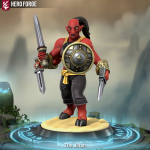 JOZHALS (Terrors of Athas)
Work in Progress
KREENS (Savage Species)
Work in Progress
KUO-TOAS (MM)
JOZHALS (Terrors of Athas)
Work in Progress
KREENS (Savage Species)
Work in Progress
KUO-TOAS (MM)
Kuo-toas are known through many of the lands of the Southern Heartlands as well as those of the Far South. However, they are not known for being friendly. Kuo-toas are almost never encountered inland on Harqual instead being known for raiding coastal communities for food and treasure. For years this was the largest threat off the shore of Avion and the city-states of the Storm Peninsula. Now with the tabaxi on the rise kuo-toas are less of a threat. (The tabaxi don't like them except as food.)
As a result, open water-dwelling kuo-toas, in that region, have begun to move farther south. However, those that live underground have stayed true to their lairs and refuse to give up the fight for a region they consider rightly theirs. These underground-dwelling kuo-toas are finding themselves forced to align with other Underearth races, especially deep minotaurs. They often raid aboveground communities, along riverbanks, for slaves to sell to deep minotaurs. The rural communities of tabaxi, living along the River of Tu, have been hardest hit by these raids.
However, the kuo-toas are quickly finding that tabaxi don't make good slaves, as they are too proud and violent. Thus, the various communities struggling for survival along the River of Storms have become the kuo-toas newest targets. Even the city of Tallawan, located at the mouth of said river, has had problems with kuo-toan raiders. (The kuo-toas often attack en masse through the sewer system, dragging citizens back with them into the Underearth. This, plus the continued threat of the tabaxi makes life in Tallawan difficult, to say the least.
Kuo-toan raiders from the open sea are still a major factor along the coast of Guardian Bay, and kuo-toas are considered a major threat to the stability of the region. Izmer, in fact, has a standing bounty of 30gp per head. While that might seem like a lot, kuo-toas are a major problem for Izmer. Not only do they raid from the sea, but dozens of kuo-toan bands and/or tribes are known to attack river communities along the length of the Fire River as far inland as Pretensa. They are a constant threat from the depths of the two major lakes in the region. (So much so that the communities around those lakes are made up of NPCs much higher in level than you'd normally find.)
In the Far South, kuo-toas are less of a problem from the sea, as the water seems to be too warm for them. Instead they are found only underground. The kuo-toas of the Far South have some dealings with the despotic communities of Siafox and Tulsax on the Varan Peninsula, as well as the many warlords who ride through the region. Kuo-toas have been spotted in the trading bazaars of such cities as Arhein, Cutte, Fialli, Fyrdin, Osebye, Quave, Rhid, Thenin, Tidad, and Varanhold. Note that not all of these communities welcome kuo-toas, forcing the fish men to conduct their dark trade in secret. The cities of Thenin and Arhein are a place where kuo-toas have, recently, been driven underground, as the Republic of the Thorn re-embraces the worship of Jalivier.
Kuo-toas are not available as a PC race; however, a player can choose to play a half-kuo-toa (see below).
Half-Kuo-toas (Bastards & Bloodlines)
Work in Progress
THE LUMINOUS (Mythic Races)
The luminous of Harqual are descendants of the gray elves of Amylinyon who were beset by an evil warlord during the time known as the Black Wars. Most of the gray elves were either killed or taken as slaves by the warlord and the elven traitor that helped him.
A small few refused to surrender, willing to sacrifice themselves to protect their ancient homeland. Long believers in the power of righteousness and good, the elves that would become the luminous would surely have been wiped out if not for the intervention of the god Jalivier, known as the Defender of the Light.
He had long watched them and felt a kinship with the besieged elves of Amylinyon, who had long ago begun to worship him and the Interloper God known as Apollo. Jalivier knew that if any were to survive, he would have to intervene. Thus, Jalivier, with Apollo's help, transform the gray elves of Amylinyon into the Luminous. And while Amylinyon was lost, now known as the Ruins of the Gray, the luminous continue to live on Harqual as native Outsiders.
The luminous appear to be humanoid-like in appearance and have heights and weights similar to elves. However, the only feature that gives away their former elven heritage are the pointed luminescent ears on their head. A luminous' body is made up of pure positive energy, which is disturbing to behold. A luminous has semitransparent skin, no body or facial hair, and no physical features like other creatures do. However, a luminous' body has just enough features to distinguish between males and females.
The luminous have become solitary creatures since the destruction of Amylinyon and rarely associate with other races. They do still feel a kinship with the elves of Harqual, and have also been known to live amongst humans, especially in the lawfully aligned Kingdom of Navirosov and Monarchy of Avion.
See the FFG sourcebook Mythic Races for more details about the luminous including racial statistics.
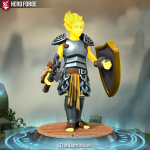 RAKSHASAS (MM)
Work in Progress
SPELL WEAVERS (MM 2)
RAKSHASAS (MM)
Work in Progress
SPELL WEAVERS (MM 2)
The spell weavers are an ancient, six-armed race, which is considered to be a dead or dying race. Most people have never met a spell weaver, or at least, they don’t remember the meeting.
What is known about them in often just conjecture or based on what has been discovered through the exploration of the dozens of spell weaver ruins found throughout the region known as the Thunder Lands, as well as several hidden vaults scattered throughout the Great Expanse.
Spell weavers have a natural ability for magic, especially cold and necromantic magic. It is also believed that a small number of them, have the ability to use psionic powers, but this just might be unfounded speculation.
Spell weavers are not available as a PC race.
THE YUAN-TI (MM)
The yuan-ti aren't, by their nature, underground dwellers instead preferring warm forests. However, the few warm forests on Harqual are dominated by other species, forcing the yuan-ti to either move off the continent proper or underground. Most choose to move underground, which enables them to constantly war against those that displaced them from their rightful homelands.
Heverkent Forest, which surrounds the Hinderfall Mountains, is the best example of this. The Mortals War drove the gnomes south, away from the expanding evil of the Empire of Swords, until they reached the Far South. Here they sought to find protection and peace in the depths of Heverkent. What they found was more conflict.
The good denizens of the forest were fighting a losing battle against the yuan-ti. Tired of running the gnomes allied with the halflings, rakasta, and fey of the south against the yuan-ti. The result was the snake men being overwhelmed by an influx of new enemies. They had little choice left, flee or die.
They chose to disappear into the earth to live to fight another day.
Heverkent quickly became known as a bastion for good-hearted creatures and nature lovers. Ancient yuan-ti idols that stood from the time of ancient Valossa were torn down. The evil of the yuan-ti waned until the time of the First and Second Ogre Wars. The yuan-ti had refused to be silent anymore, allying themselves with evil Underearth creatures.
They came up out of the earth in the hundreds of thousands. They had one purpose, destroy the gnomes and their allies. However, the gnomes had prepared strong defenses with the help of Heverkent's sylvan population, including the treants. Still, the onslaught was too much for the small folk and the yuan-ti soon had the advantage.
Heverkent was at risk of being lost to the snake men once again.
Yet, the gnomes had an ally the yuan-ti couldn't have expected to face. The goddess Immotion, Patron of Magic, favored the gnomes of Heverkent. She increased their knowledge of magic, giving them innate abilities, as well as a closer understanding of the natural world. This gift of 'the touch of magic' tipped the scales of war in the favor of the gnomes and their allies.
The yuan-ti had no choice but to retreat into the earth once more. Here, these snake men have remained, brooding in the darkness. They often align themselves with morlocks, who hate the rockwood gnomes of Heverkent Forest and Hinderfall Mountains as much as the yuan-ti do, as well as bugbears and, sometimes, evilly-aligned kobolds.
Note that the Far South has two other major forests where the yuan-ti once held sway — the Merewood and the Lilliputian Jungle. The former was once home to a more powerful race of yuan-ti related to the ancients of Valossa. The Merewood still holds the many ruins of this once grand civilization's cities and monuments. The Lilliputian Jungle is home to a great nation of lightfoots who live much like elves do in the north. The yuan-ti have little tolerance for the halflings that exist in their jungle home; however, the halflings outnumber the yuan-ti three-to-one so there isn't much the yuan-ti can do to rid the jungle of the halfling infestation.
Other places the yuan-ti are known to live, both above and below ground, are the island of Ochel (largest of the Falchion Islands), the Mallowood, the Elra Forest (which surrounds Lake Varan), the Nesin Islands, and the southern tip of the island of Thyer.
Yuan-ti Purebloods
Only yuan-ti purebloods are available as PCs. Most of these pureblood PCs are outcasts of their race, often hiding from their former masters. Yuan-ti purebloods have all the racial traits as per that listed on pages 263 and 264 of D&D Monster Manual v.3.5, except as follows: Special Qualities: no Alternate Form ability, spell resistance equal to class levels + 7. Automatic Languages: Yuan-Ti, Undercommon. Bonus Languages: Abyssal, Common, Draconic, Gnome, Halfling, and Valossan.
WITCHKNIVES (MM 3)
Witchknives are a psychically-gifted race that is rare on Harqual. They tend to live in deserts and other inhospitable places. They are very rare in the Great Expanse, however, due to centuries of warfare between their race and the desert elves that now control much of that land. Why the war started is unknown, but to say that desert elves and witchknives hate each other is understatement.
Witchknife Traits
See page 195 of D&D Monster Manual III for this races stats, modified as noted below:
- +4 to Dexterity, -2 to Constitution, +2 to Intelligence, +2 to Wisdom, +4 to Charisma.
- Psionics: To be changed to use the rules from XPH.
- Favored Class: Rogue or wilder.
- Level Adjustment: +2.

